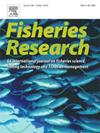与环境驱动因素相关的鳕鱼长度分布的高分辨率时空分析
IF 2.3
2区 农林科学
Q2 FISHERIES
引用次数: 0
摘要
地中海渔业面临严峻挑战,欧洲鳕(Merluccius Merluccius)既具有很高的生态和商业价值,又存在严重的过度捕捞。物种复杂的空间种群结构使可持续管理变得更加复杂,需要高分辨率的数据,如长度分布。在这项研究中,我们应用人工智能在马略卡岛(Mallorca Island)产生了船日水平上的连续时空数据,该数据代表了粮农组织主要捕鱼区37内地中海地理统计分区域之一。从2021年到2023年,我们分析了18000多张登陆鳕鱼箱的图像,我们的方法捕获了大约77 %的登陆生物量,确保了不同渔场的代表性覆盖。通过整合自组织地图(Self-Organizing Maps)、随机森林(Random Forest)和广义线性混合模型(Generalized Linear Mixed Models),我们发现深度和地理区域是鳕鱼大小的关键驱动因素:较小的个体在东北和西南浅水区占主导地位,与已知的幼鱼栖息地相对应。春季和秋冬季,小长类的流行率增加。尽管捕获长度的变化很大程度上是特定于船只的,反映了基于msamtier的策略,但这种方法能够探测到亚种群的动态。这种方法提供了一种具有成本效益的、依赖渔业的工具,补充了现有的数据源。在这里获得的高分辨率、明确的空间见解为旨在确保地中海渔业可持续发展的适应性、区域定制管理战略提供了宝贵的基础。本文章由计算机程序翻译,如有差异,请以英文原文为准。
High-resolution spatial and temporal analysis of hake length distribution in relation to environmental drivers
Mediterranean fisheries face critical challenges, with European hake (Merluccius merluccius) exemplifying both high ecological and commercial value and severe overexploitation. Sustainable management is further complicated by the species’ complex spatial population structure, necessitating high-resolution data such as on length distributions. In this study, we applied artificial intelligence to produce continuous spatial and temporal data on hake length distributions at the boat-day level in Mallorca Island, representative of one of the Mediterranean geographical statistical subareas within FAO major fishing area 37. Analyzing over 18,000 images of landed hake boxes from 2021 to 2023, our method captured approximately 77 % of the landed biomass, ensuring representative coverage of diverse fishing grounds. By integrating Self-Organizing Maps, Random Forest, and Generalized Linear Mixed Models, we identified depth and geographical areas as a key drivers of hake size: smaller individuals predominated in shallow NE and SW zones, corresponding with known juvenile habitats. Seasonal patterns further revealed an increased prevalence of small-length classes during spring and autumn-winter. Although variations in catch length were largely boat-specific-reflecting métier-based strategies-this approach enabled the detection of subpopulation dynamics. This approach offers a cost-effective, fisheries-dependent tool that complements existing data sources. The high-resolution, spatially explicit insights gained here provide a valuable foundation for adaptive, regionally tailored management strategies aimed at ensuring sustainable Mediterranean fisheries.
求助全文
通过发布文献求助,成功后即可免费获取论文全文。
去求助
来源期刊

Fisheries Research
农林科学-渔业
CiteScore
4.50
自引率
16.70%
发文量
294
审稿时长
15 weeks
期刊介绍:
This journal provides an international forum for the publication of papers in the areas of fisheries science, fishing technology, fisheries management and relevant socio-economics. The scope covers fisheries in salt, brackish and freshwater systems, and all aspects of associated ecology, environmental aspects of fisheries, and economics. Both theoretical and practical papers are acceptable, including laboratory and field experimental studies relevant to fisheries. Papers on the conservation of exploitable living resources are welcome. Review and Viewpoint articles are also published. As the specified areas inevitably impinge on and interrelate with each other, the approach of the journal is multidisciplinary, and authors are encouraged to emphasise the relevance of their own work to that of other disciplines. The journal is intended for fisheries scientists, biological oceanographers, gear technologists, economists, managers, administrators, policy makers and legislators.
 求助内容:
求助内容: 应助结果提醒方式:
应助结果提醒方式:


